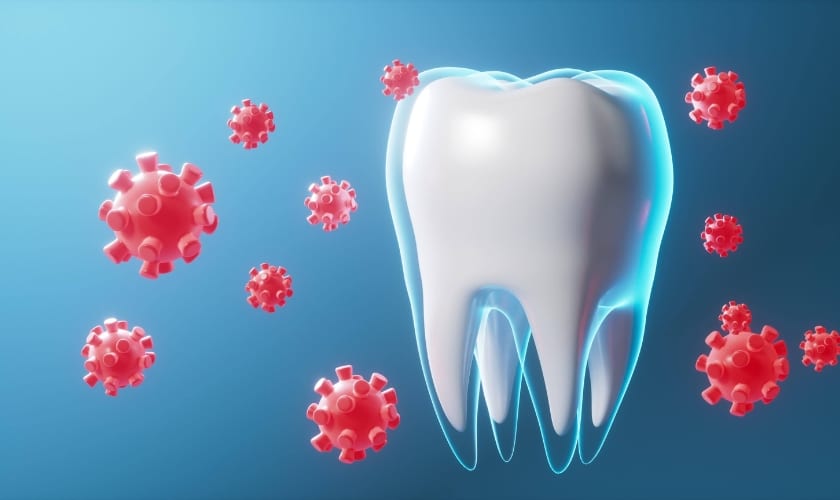Book now

What Are Three Diseases That Affect The Teeth?

What Are Three Diseases That Affect The Teeth?
Keeping the mouth healthy is important for general health since many illnesses can have a serious effect on teeth and surrounding tissues. Effective management of these disorders requires early recognition and treatment. We’ll look at three common dental illnesses in this blog, along with their symptoms and management options.
1. Dental Caries (Tooth Decay)
Overview: Dental caries, sometimes referred to as cavities or tooth decay, is one of the most prevalent dental diseases. It shows up when harmful bacteria in the mouth produce acids that erode tooth enamel. Over time, this can lead to the formation of cavities and, if left untreated, can cause severe damage to the tooth structure.
Symptoms:
- Tooth Sensitivity: Sensitivity to hot, cold, or sweet foods may indicate tooth decay early on.
- Visible Cavities: Dark spots or holes on the teeth may indicate the presence of cavities.
- Pain: Persistent toothache or discomfort when chewing can signal advanced decay.
Causes:
- Poor Oral Hygiene: Inadequate brushing and flossing allow plaque buildup, which harbors decay-causing bacteria.
- High Sugar Intake: Frequent consumption of sugary foods and drinks provides fuel for bacteria that produce harmful acids.
- Lack of Fluoride: Fluoride helps to strengthen tooth enamel and protect against decay. A deficiency can increase susceptibility to cavities.
Prevention and Treatment:
- Regular Brushing and Flossing: Maintain good oral hygiene by brushing twice a day and flossing daily.
- Professional Cleanings: Regular dental visits for professional cleanings can help remove plaque and tartar buildup.
- Fluoride Treatments: Applying fluoride varnishes or gels can help strengthen enamel and prevent cavities.
- Dental Fillings: If decay is detected, a dentist will extract the tooth’s decaying area and fill it with an appropriate substance to restore both the tooth’s look and functionality.
For children, visiting a pediatric dentist in Bradley can ensure that cavities are detected early and managed effectively to prevent long-term damage.
2. Gingivitis
Overview: Gingivitis is the earliest stage of gum disease, characterized by inflammation of the gingiva (gums). Plaque buildup on the teeth and gums is usually the cause of it. Gingivitis can develop into a more serious type of gum disease, such as periodontitis, if treatment is not received.
Symptoms:
- Red, Swollen Gums: The gums may appear red, swollen, and tender.
- Bleeding: Bleeding during brushing or flossing is a common sign of gingivitis.
- Bad Breath: Chronic foul breath has been linked to gum disease.
Causes:
- Plaque Buildup: A sticky layer of germs called plaque accumulates on teeth. If not eliminated by careful brushing and flossing, it can irritate the gum tissue.
- Smoking or Chewing Tobacco: Tobacco use can raise the possibility of getting additional gum disorders, including gingivitis.
- Certain Medical Conditions: Conditions such as diabetes and hormonal changes can make individuals more susceptible to gum disease.
Prevention and Treatment:
- Good Oral Hygiene: Regular brushing and flossing help to remove plaque and prevent gingivitis.
- Professional Cleanings: Dental cleanings remove plaque and tartar buildup that cannot be addressed by at-home care alone.
- Antibacterial Mouthwashes: Using mouthwashes with antibacterial properties can help reduce plaque and inflammation.
- Quitting Tobacco: Eliminating tobacco use can improve gum health and reduce the risk of gingivitis.
For children, it’s important to address gingivitis early to prevent progression to more serious gum conditions. Regular check-ups with a pediatric dentist in Bradley can help manage and prevent gingivitis.
3. Periodontitis
Overview: A dangerous gum illness called periodontitis erodes the tooth’s supporting bone as well as soft tissue. If left untreated, the advanced stage of gum disease might result in tooth loss. Periodontitis often starts as gingivitis but progresses due to the lack of treatment.
Symptoms:
- Receding Gums: Gums may begin to recede from the teeth, creating pockets that become infected.
- Loose Teeth: Advanced periodontitis can cause teeth to become loose or shift position.
- Pus Formation: Pockets around the teeth may become infected and produce pus.
Causes:
- Chronic Plaque and Tartar: Plaque that turns into tartar can irritate the gum tissues and, if not removed, lead to periodontitis.
- Genetic Factors: Certain people could have a hereditary predisposition to more severe forms of gum disease.
- Poor Nutrition: The absence of vital nutrients can impair the immune system and oral health.
Prevention and Treatment:
- Deep Cleanings: Scaling and root planing are non-surgical methods for getting rid of tartar and plaque under the gum line.
- Surgical Treatments: In severe cases, surgical interventions may be necessary to restore gum health and bone structure.
- Ongoing Maintenance: Regular dental visits for monitoring and maintenance are essential to keep periodontitis under control.
- Lifestyle Changes: Improving oral hygiene, quitting smoking, and eating a balanced diet can aid in controlling and preventing periodontitis.
Overall, dental diseases such as dental caries, periodontitis, and gingivitis can have a serious negative effect on dental health if not properly managed. Keeping your smile healthy requires knowledge of the signs, causes, and preventative strategies for various disorders.
For children, it’s especially important to establish good oral hygiene habits and seek regular check-ups with a pediatric dentist in Bradley to catch and address any issues early.
By prioritizing oral health and adhering to preventive care recommendations, you can help ensure the well-being of your teeth and gums, setting the stage for a lifetime of healthy smiles. If you have concerns about your or your child’s dental health, don’t hesitate to consult with a dental professional for personalized advice and care.
Frequently Asked Questions
Yes, caries can develop under a dental crown if the margins are not sealed properly or if there is poor oral hygiene. Bacteria can enter through tiny gaps and cause decay underneath the crown.
Yes, chronic gingivitis can lead to gum recession. If not treated, the inflammation caused by gingivitis can weaken the gum tissue, leading to its gradual receding from the teeth.
While periodontitis primarily affects the jawbone, the chronic inflammation associated with the disease has been linked to systemic conditions, including osteoporosis, which affects bone density in other parts of the body.







